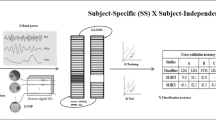Abstract
In this paper, a comparative evaluation of state-of-the art feature extraction and classification methods is presented for five subjects in order to increase the performance of a cue-based Brain–Computer interface (BCI) system for imagery tasks (left and right hand movements). To select an informative feature with a reliable classifier features containing standard bandpower, AAR coefficients, and fractal dimension along with support vector machine (SVM), Adaboost and Fisher linear discriminant analysis (FLDA) classifiers have been assessed. In the single feature-classifier combinations, bandpower with FLDA gave the best results for three subjects, and fractal dimension and FLDA and SVM classifiers lead to the best results for two other subjects. A genetic algorithm has been used to find the best combination of the features with the aforementioned classifiers and led to dramatic reduction of the classification error and also best results in the four subjects. Genetic feature combination results have been compared with the simple feature combination to show the performance of the Genetic algorithm.




Similar content being viewed by others
References
Andrew Webb (1999) Statistical pattern recognition, Oxford University Press, New York
Bozorgzadeh Z, Birch GE, Mason SG (2000) The LF-ASD brain computer interface: on-line identification of imagined finger flexions in the spontaneous EEG of able-bodied subjects. IEEE Int Conf Acoustic Speech Proc 6:2385 –2388
Deriche M, Al-Ani A (2001) A new algorithm for EEG feature selection using mutual information. IEEE international conference on acoustics, speech, and signal processing 2001. Proceedings. ICASSP 2:1057–1060
Duda RO, Hart PE, Stok DG (2001) Pattern classification. Wiley, New York
Esteller R, Vachtsevanos G, Echauz J, Lilt B (1999) A comparison of fractal dimension algorithms using synthetic and experimental data. ISCAS Proceedings, IEEE international symposium on circuits and systems 3:199–202
Esteller R, Vachtsevanos G, Echauz J, Henry T, Pennell P, Epstein C, Bakay R, Bowen C, Litt B (1999) Fractal dimension characterizes seizure onset in epileptic patients. Proc IEEE Int Conf Acoust Speech Signal process 4:2343–2346
Esteller R (2000) Detection of seizure onset in epileptic patients from intracranial EEG signals. Ph. D. thesis, School of Electrical and Computer Engineering, Georgia Institute of Technology
Flotzinger D, Pregenzer M, Pfurtscheller G (1994) Feature selection with distinction sensitive learning vector quantisation and genetic algorithms. IEEE Int Conf Comput Intell 6:3448–3451
Goldberg (1989) Genetic algorithm, Prentice-Hall, New York
Goldberger AL, Amaral LA, Hausdorff JM, Ivanov P, Peng CK, Stanley HE (2002) Fractal dynamics in physiology: alterations with disease and aging. Proc Natl Acad Sci USA 99(Suppl 1):2466–2472
Graimann B, Huggins JE, Levine SP, Pfurtscheller G (2004) Toward a direct brain interface based on human subdural recordings and wavelet-packet analysis. IEEE Trans Biomed Eng 51(6):954–962
Guger C, Edlinger G, Harkam W, Niedermayer I, Pfurtscheller G (2003) How many people are able to operate an EEG-based Brain–Computer interface (BCI)? IEEE Trans Neural Syst Rehab Eng 11(2):145–147
Haselsteiner E, Pfurtscheller G (2000) Using time-dependent neural networks for EEG classification. IEEE Trans on Rehab Eng 8:457–463
Kalcher J, Flotzinger D, Pfurtscheller G (1992) A new approach to a Brain–Computer-interface (BCI) based on learning vector quantization (LVQ3). Proc Annu Int Conf IEEE 4:1658–1659
Murphey YL, Zhihang Chen, Hong Guo (2001) Neural learning using AdaBoost. Proceedings IJCNN, International joint conference on neural networks 2:1037–1042
Murua A (2002) Upper bounds for error rates of linear combination of classifiers. IEEE Trans Pattern Anal Mach intell 24(5):591–602
Obermaier B, Neuper C, Guger C, Pfurtscheller G (2001) Information transfer rate in a five-classes Brain–Computer interface. IEEE Rehab Eng 9:283 –288
Pfurtscheller G, Neuper C, Schlogl A, Lugger K (1998) Separability of EEG signals recorded during right and left motor imagery using adaptive autoregressive parameters. IEEE Trans on Rehab Eng 6:316–328
Pfurtscheller G;Lopes da Silva (1999) Event related desynchronization. Hand book of electroenceph. and clinical Neurophisiology. vol 6 revised edition. Elsevier, Amsterdam
Pfurtscheller G, Neuper C (2001) Motor imagery and direct Brain–Computer communication. Proceedings of the IEEE 89:1123–1134
Schlögl A, Flotzinger D, Pfurtscheller G (1997) Adaptive autoregressive modeling used for single-trial EEG classification. Biomed Tech 42:162–167
Vapnic VN (1998) Statistical learning theory. Wiley, New York
Wolpaw JR, McFarland DJ, Vaughan TM (2000) Brain–Computer interface research at the Wadsworth Center. IEEE Trans Rehab Eng 8:222–226
Author information
Authors and Affiliations
Corresponding author
Rights and permissions
About this article
Cite this article
Boostani, R., Graimann, B., Moradi, M.H. et al. A comparison approach toward finding the best feature and classifier in cue-based BCI. Med Bio Eng Comput 45, 403–412 (2007). https://doi.org/10.1007/s11517-007-0169-y
Received:
Accepted:
Published:
Issue Date:
DOI: https://doi.org/10.1007/s11517-007-0169-y




